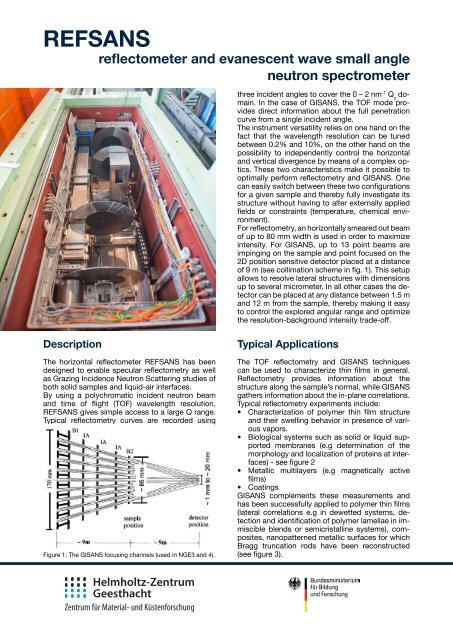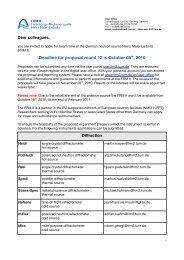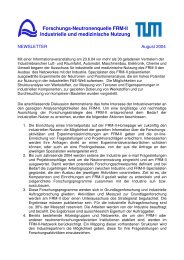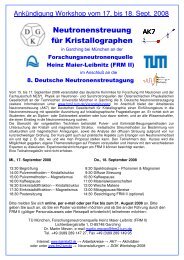Neutron Source - FRM II - Technische Universität München
Neutron Source - FRM II - Technische Universität München
Neutron Source - FRM II - Technische Universität München
You also want an ePaper? Increase the reach of your titles
YUMPU automatically turns print PDFs into web optimized ePapers that Google loves.
REFSANS<br />
reflectometer and evanescent wave small angle<br />
neutron spectrometer<br />
Description<br />
The horizontal reflectometer REFSANS has been<br />
designed to enable specular reflectometry as well<br />
as Grazing Incidence <strong>Neutron</strong> Scattering studies of<br />
both solid samples and liquid-air interfaces.<br />
By using a polychromatic incident neutron beam<br />
and time of flight (TOF) wavelength resolution,<br />
REFSANS gives simple access to a large Q range.<br />
Typical reflectometry curves are recorded using<br />
Figure 1: The GISANS focusing channels (used in NGE3 and 4).<br />
three incident angles to cover the 0 – 2 nm -1 Q z domain.<br />
In the case of GISANS, the TOF mode provides<br />
direct information about the full penetration<br />
curve from a single incident angle.<br />
The instrument versatility relies on one hand on the<br />
fact that the wavelength resolution can be tuned<br />
between 0.2% and 10%, on the other hand on the<br />
possibility to independently control the horizontal<br />
and vertical divergence by means of a complex optics.<br />
These two characteristics make it possible to<br />
optimally perform reflectometry and GISANS. One<br />
can easily switch between these two configurations<br />
for a given sample and thereby fully investigate its<br />
structure without having to alter externally applied<br />
fields or constraints (temperature, chemical environment).<br />
For reflectometry, an horizontally smeared out beam<br />
of up to 80 mm width is used in order to maximize<br />
intensity. For GISANS, up to 13 point beams are<br />
impinging on the sample and point focused on the<br />
2D position sensitive detector placed at a distance<br />
of 9 m (see collimation scheme in fig. 1). This setup<br />
allows to resolve lateral structures with dimensions<br />
up to several micrometer. In all other cases the detector<br />
can be placed at any distance between 1.5 m<br />
and 12 m from the sample, thereby making it easy<br />
to control the explored angular range and optimize<br />
the resolution-background intensity trade-off.<br />
Typical Applications<br />
The TOF reflectometry and GISANS techniques<br />
can be used to characterize thin films in general.<br />
Reflectometry provides information about the<br />
structure along the sample’s normal, while GISANS<br />
gathers information about the in-plane correlations.<br />
Typical reflectometry experiments include:<br />
• Characterization of polymer thin film structure<br />
and their swelling behavior in presence of various<br />
vapors.<br />
• Biological systems such as solid or liquid supported<br />
membranes (e.g determination of the<br />
morphology and localization of proteins at interfaces)<br />
- see figure 2<br />
• Metallic multilayers (e.g magnetically active<br />
films)<br />
• Coatings<br />
GISANS complements these measurements and<br />
has been successfully applied to polymer thin films<br />
(lateral correlations e.g in dewetted systems, detection<br />
and identification of polymer lamellae in immiscible<br />
blends or semicristalline systems), composites,<br />
nanopatterned metallic surfaces for which<br />
Bragg truncation rods have been reconstructed<br />
(see figure 3).








